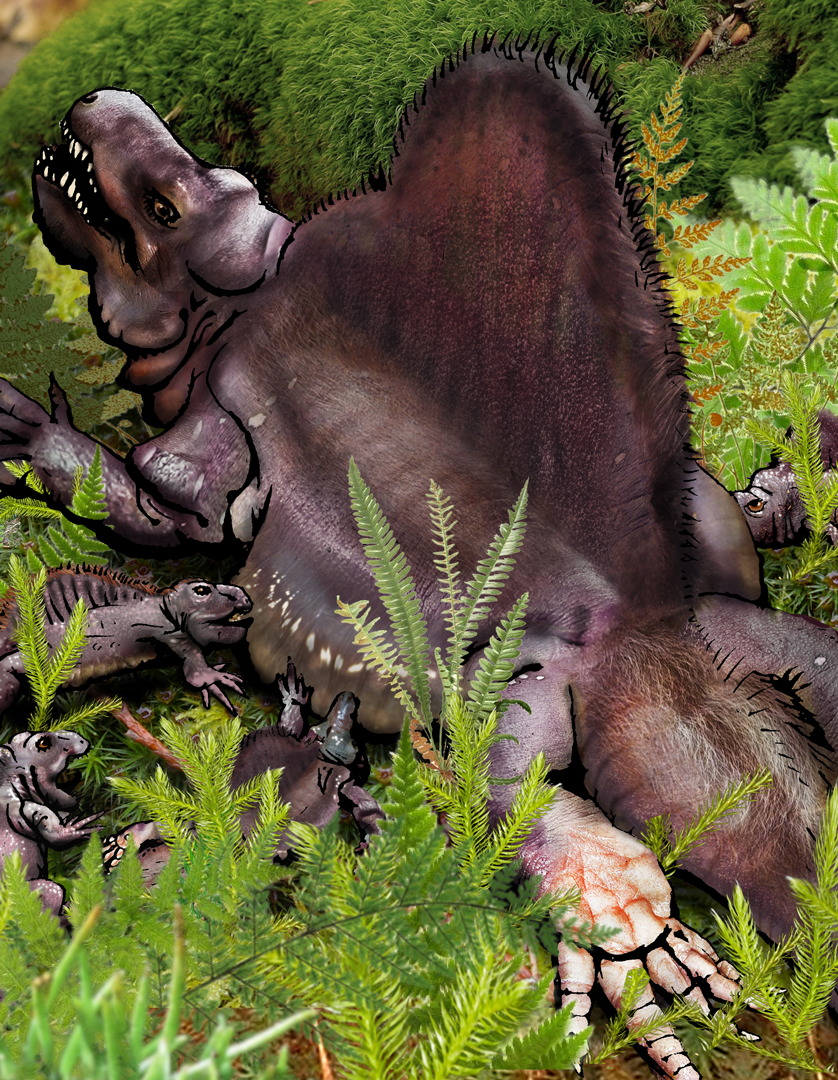ShopDreamUp AI ArtDreamUp
Deviation Actions
Description
Dimetrodon and its kin have often been described as "mammal-like reptiles", but in fact they they are just as closely related to modern reptiles as we are (in terms of shared descent). Creatures like Dimetrodon, Moschops, Lystrosaurus, Cynognathus, Morganucodon, etc. are more properly termed "stem-mammals", meaning that they are not mammals, but are more closely related to mammals than to any other living organisms.
We can infer, in the absence of direct evidence, that all stem-mammals probably possessed any characteristics shared by us mammals and our closest living non-mammalian relatives, the sauropsids (turtles, tuataras, lizards [including snakes], crocodylians, and birds). But mammalian characteristics not shared by sauropsids are trickier. When did hair evolve? When did lactation evolve? We have a few clues but no definite answers.
In this piece, I have pushed fur back to an extremely early time -- Dimetrodon is one of the furthest stem-mammals from Mammalia proper. While we know that a later stem-mammal, Estemmenosuchus, had glandular skin without any sign of fur, it is possible that fur evolved earlier and was simply lost or reduced in some lineages, as it has been in many lineages of placental mammal.
I have also posited parental feeding, but not, strictly speaking, lactation. Other lineages of tetrapod, including caecilians and pigeons, have evolved ways of feeding the young from foodstuffs produced by the mother. The mother Dimetrodon's sides are swollen with nutritious substances which seep out as her pups gobble it up. Is it milk? Sort of and sort of not.
Finally, I have scrupulously avoided any suggestion that these are in any way reptilian. They do retain some plesiomorphies evidenced in some reptiles, amphibians, and lungfishes, such as a sprawling gait, belly scales, and acute color vision, but they lack the dry skin and derived scales of true reptiles. Not a single sauropsid texture was used in the photocollage; instead they have the textures of Hippopotamus, Phacochoerus, Procyon, Homo, Zaglossus, Caecilia, Litoria, and even Neoceratodus. These Dimetrodon are moist, glandular creatures -- not reptiles at all.
We can infer, in the absence of direct evidence, that all stem-mammals probably possessed any characteristics shared by us mammals and our closest living non-mammalian relatives, the sauropsids (turtles, tuataras, lizards [including snakes], crocodylians, and birds). But mammalian characteristics not shared by sauropsids are trickier. When did hair evolve? When did lactation evolve? We have a few clues but no definite answers.
In this piece, I have pushed fur back to an extremely early time -- Dimetrodon is one of the furthest stem-mammals from Mammalia proper. While we know that a later stem-mammal, Estemmenosuchus, had glandular skin without any sign of fur, it is possible that fur evolved earlier and was simply lost or reduced in some lineages, as it has been in many lineages of placental mammal.
I have also posited parental feeding, but not, strictly speaking, lactation. Other lineages of tetrapod, including caecilians and pigeons, have evolved ways of feeding the young from foodstuffs produced by the mother. The mother Dimetrodon's sides are swollen with nutritious substances which seep out as her pups gobble it up. Is it milk? Sort of and sort of not.
Finally, I have scrupulously avoided any suggestion that these are in any way reptilian. They do retain some plesiomorphies evidenced in some reptiles, amphibians, and lungfishes, such as a sprawling gait, belly scales, and acute color vision, but they lack the dry skin and derived scales of true reptiles. Not a single sauropsid texture was used in the photocollage; instead they have the textures of Hippopotamus, Phacochoerus, Procyon, Homo, Zaglossus, Caecilia, Litoria, and even Neoceratodus. These Dimetrodon are moist, glandular creatures -- not reptiles at all.
Image size
838x1080px 1.78 MB
© 2013 - 2024 keesey
Comments18
Join the community to add your comment. Already a deviant? Log In
I also wonder if ancient synapsids also laid eggs which they kept in a pouch, similarly to modern monotremes.



































